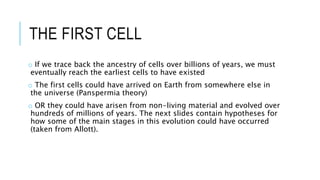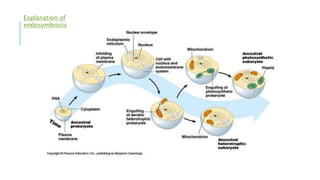9. the origin of cells
- 1. 9. THE ORIGIN OF CELLS 1.5 – Cells can only be formed by division of pre-existing cells 1.5 – The first cell must have arisen from non-living materials 1.5 – The origin of eukaryotic cells can be explained by the endosymbiotic theory
- 2. REVISION - CELL THEORY o The development of cell theory has taken hundreds of years o Much of its development parallels with advances in technology – including staining techniques and the development of both light and electron microscopes o The three main principles of cell theory are: 1. All organisms are composed of one or more cells 2. Cells are the smallest units of life 3. All cells come from pre-existing cells
- 3. REVISION – PASTEUR’S EXPERIMENT o Louis Pasteur performed the famous swan-necked flask experiment to prove the third main point of cell theory – this experiment ultimately disproved the long standing idea of ‘spontaneous generation’ o This provided evidence in support of the third point of cell theory ‘all cells come from pre-existing cells”
- 5. THE FIRST CELL o One obvious missing component of cell theory is how the first cell arose o The first cells must have arisen from non-living material o Also what is not explained by cell theory is how cells progressed from simple, non-compartmentalised prokaryotes to a complex, highly compartmentalized eukaryote
- 6. THE FIRST CELL o If we trace back the ancestry of cells over billions of years, we must eventually reach the earliest cells to have existed o The first cells could have arrived on Earth from somewhere else in the universe (Panspermia theory) o OR they could have arisen from non-living material and evolved over hundreds of millions of years. The next slides contain hypotheses for how some of the main stages in this evolution could have occurred (taken from Allott).
- 10. ENDOSYMBIOSIS o The theory of endosymbiosis helps explain the evolution of eukaryotic cells by looking at the origin of mitochondria and chloroplasts o The key points to the theory are: o About 2 billion years ago a bacterial cell took up residence inside a eukaryotic cell o The eukaryotic cell acted as a ‘predator’, bringing the bacterial cell inside (by endocytosis) o The eukaryotic cell and the bacterial cell formed a symbiotic relationship, in which both organisms lived in contact with one another o The bacterial cell then went through a series of changes to ultimately become a mitochondrion o In this process the eukaryote helped the bacteria by providing protection and carbon compounds. The bacteria, after a series of changes, became specialised in providing the eukaryote with ATP. o It is thought that mitochondria were originally aerobic heterotrophic bacteria and chloroplasts were originally cyanobacteria What is endosymbiosis?
- 12. EVIDENCE FOR ENDOSYMBIOSIS o Mitochondria and chloroplasts are similar in size and structure to bacteria o Both organelles are bound by a double membrane – the outer membrane may be derived from the engulfing vesicle, and the inner one may be derived from the plasma membrane of the original prokaryote o Mitochondria and chloroplasts contain a limited amount of genetic material and divide by fission (independently of the host cell). Their DNA is a circular loop like that of prokaryotes. o Although most of the proteins within mitochondria and chloroplasts are now produced by the eukaryotic host, they do have their own ribosomes and they do produce some proteins. Their ribosomes resemble those of prokaryotes.
- 13. EVIDENCE FOR ENDOSYMBIOSIS(TAKEN FROM PEARSON) o “The final bit of evidence for endosymbiotic theory is DNA. DNA provides a code made up of 64 different ‘words’. Interestingly, this code has the same meaning in nearly all organisms on Earth and is said to be ‘universal’. There are only slight variations, which can be explained by changes since the common origin of life on our planet. As mentioned, the mitochondria of eukaryotic cells have a DNA code that more closely resembles bacteria than eukaryotic cells. Most scientists believe that the more DNA two organisms have in common, the more closely related they are to one another.”













